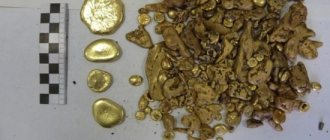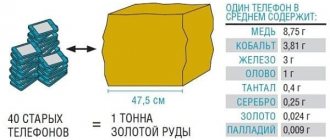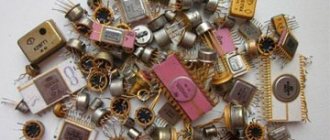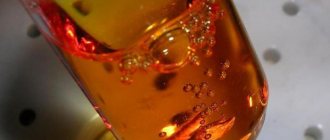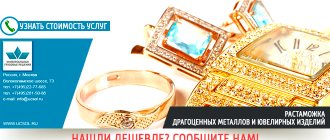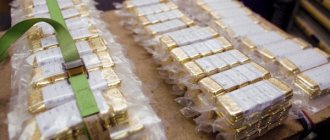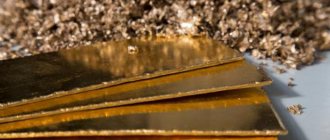In the case when there is a sale of precious minerals within the country or abroad, which is not controlled, this undermines the stability of the market, leads to the fact that the metals depreciate, and currency rates fluctuate. To prevent such a situation from happening, the extraction and sale of natural materials is the responsibility of state authorities. To conduct such activities you will need to obtain a special permit or license. An article of the Criminal Code of the Russian Federation is provided for illegal trafficking of precious metals.
Exceptions
Some states of precious metals will not be considered as the subject of Article 191 of the Criminal Code of the Russian Federation. These include:
- Jewelry. They are understood as objects and various kinds of decorations that are made using artistic processing in its various manifestations. Precious metals are processed in combination with semi-precious, precious or counterfeit stones and other natural materials. Or they can be made entirely of precious metal;
- Household products made from precious metals. This means that such an item does not belong to the type of personal jewelry; items used in everyday life are used. This could be dishes, weapons, religious objects, etc.;
- Objects of art, antiquities or antiques, in the manufacture of which precious metals or stones were used;
- Scrap jewelry and other household items. These may be unusable, broken jewelry and items that can be recycled into other products;
- Gold leaf. These are thin films of gold that are used for decorative purposes;
- Discs for dental prostheses;
- State awards made using precious stones and metals;
- Collectible coins.
Important! In all of these cases, it is not taken into account how objects and decorations are made; it may also be a handicraft method. In addition, it does not matter whether the stamp is affixed or not. Clauses 3, 5, 7, 8 are an exception only for one-time transactions.
Specific qualifications
The specificity of the qualification of this type of act is whether this or that operation is permissible.
It is determined by the state in which precious metals and stones are located. As an example, we can consider the situation with a cut diamond that has a commercial form. It can be transferred, transported and perform other various operations only if there is a document that confirms the purchase of the stone. With the help of a document, you can prove that the stone was not misappropriated.
If we talk about the native brother of this stone, which does not have polished edges, then the performance of any actions with it by a subject who does not have a license is considered a crime.
A similar situation occurs when performing operations with stones that are not processed. Even industries that have official permission to operate with these stones and metals cannot implement it if the metals are required to replenish the budget’s gold reserves.
If even a small amount of gold dust or nuggets is in the possession of a private person, then this is fraught with criminal liability for him. This is due to the fact that an individual cannot act as a subject who is allowed to circulate stones and metals classified as precious.
Where are precious stones accepted in Moscow?
Many people invest their money in gemstones because it is practical. But in life the opposite situation may arise, and the jewelry will need to be handed over, then the person asks the question: where is the most profitable place to pawn his jewelry in Moscow?
Pawnshops accept precious stones, but often these organizations take advantage of a person’s predicament and accept jewelry at a very low price.
Jewelry factories or companies directly purchase precious stones. They will be able to sell their jewelry more profitably, for example, diamonds, rubies, opals, sapphires and many other stones. The quality and authenticity of the product will be checked by a professional expert.
By visiting our store, you will receive:
- A qualitative assessment of your jewelry by professional gemologists;
- You will be offered the highest and most favorable price for gems and precious metals;
- The transaction and assessment will have complete anonymity;
- Registration will be carried out in accordance with current legislation.
Our experts will evaluate your jewelry in an average of 15 minutes and offer good money for it; If you are satisfied with everything, the specialist will promptly complete all the necessary documents and immediately pay you the money in cash without deducting a commission.
Why is it profitable to donate stones from jewelry to an antique store?
Our store has quite a wealth of professional experience, because the staff was carefully selected and only the leading experts in the capital work for us. In our store you can always sell precious stones at a profit.
Advantages of cooperation with an antique store:
- We cooperate only within the legal framework;
- We have an online mode of operation for those clients who cannot take the time to come in person. A person just needs to take a few photos and send them to us by email or through a special mobile application, and within 15-20 minutes our specialists will answer you.
- Special customer safety is observed, so money for the product can be received either in person or using the details specified by the owner.
- The antique store will always value the trust of its customers, both regular and new.
- Our store cooperates with many registered collectors, pawn shops and colleagues from abroad, so handing over precious stones will not pose any danger.
Storage and theft
According to Instruction No. 68, precious stones and metals are stored in premises that meet the requirements prescribed by law regarding technical strength and equipment with fire and security alarms.
Important! The premises and cabinets where these items are stored must be sealed, sealed, locked and handed over to security. Only responsible persons or a commission will be able to open them, with permission obtained from management. Taking into account the specificity of the criminal act under consideration, it is necessary to consider the type of theft that is associated with the performance of professional duties. These include fraud, theft, embezzlement or misappropriation.
Initially, signs are identified that are inherent in all types of theft, including the fact that the object is property.
The property has the following characteristics:
- has a certain value, that is, if things are seized that have no material value, no crime is formed;
- the property must belong to another person, this means that the culprit is a financially responsible person;
- the cost exceeds one established minimum wage.
The objective side is expressed in the confiscation and (or) circulation of someone else’s property by the perpetrator for his own benefit. When the culprit seized an item, but did not get the opportunity to dispose of it, it is considered as theft. The act is completed from the moment of seizure and the opportunity to dispose of the property at one’s own discretion. If we consider the theft of precious metals from production, then it is considered completed from the moment the metal left the production area and was taken out through the entrance.
If an employee is detained at a checkpoint, then the offense is assessed as attempted theft. If the stolen metal was kept by the culprit for a short time, then this provides grounds for classification under Article 191 of the Criminal Code of the Russian Federation under a set of crimes.
The subjective side is represented by direct intent.
Qualifying features
Large size provided for in Part 1 of Article 191 of the Criminal Code of the Russian Federation is considered as qualifying signs of this act. Its amount is determined in the note to Article 170.2 of the Criminal Code and is equal to 2 million 250 thousand rubles.
Part two includes such qualifying criteria as the commission of an act by a group of persons by prior conspiracy or by an organized group.
Organized group:
- is sustainable;
- its members have united to commit one or more criminal acts;
- Each participant has their own role and responsibilities.
A group of persons by prior conspiracy:
- several persons (at least two) agreed to commit a crime;
- in this case, an agreement could be reached before the crime began.
Features of the investigation
The priority direction of the process of investigating a criminal act regarding precious metals and stones is their presence, which provides the basis for qualifying the act under the article in question.
If a situation arises where there are no materials that are the subject of Article 191 of the Criminal Code of the Russian Federation, further investigation becomes impossible.
After the jewelry is seized, an analysis is carried out aimed at establishing the possibility of classifying the materials as prohibited for circulation. If, after assessing the materials, it is determined that an appropriate permit is required to conduct transactions with metals and stones, then the owner is required to provide documentation confirming the legality of the transaction.
The last stage is the analysis of the transaction regarding its legality. If it is completed successfully, then criminal liability does not apply. If the legal requirements for the handling of stones and metals are not met, liability arises.
Punishment and responsibility
Retribution for illegal manipulation of stones and metals considered precious, if major damage is recorded, that is, more than 1.5 million rubles, occurs, upon establishment of guilt, under Part 1 of Art. 191 of the Criminal Code of the Russian Federation and implies five years of forced labor or serving this term in prison, and the punishment can be supplemented by a fine, the amount of which is limited to 500 thousand rubles or income for 3 years.
With the group participation of criminal entities, the punishment is provided for in Part 2 of Article 191 of the Criminal Code of the Russian Federation and consists of:
- forced labor for a period limited to five years;
- a prison term that should not exceed 7 years.
Additionally, damage compensation may be awarded in the amount of up to 1 million rubles or income for 5 years.
Now let's look at some cases from judicial practice on the illegal trafficking of precious metals and stones.
A comment
Currently, Article 191 of the Criminal Code of the Russian Federation includes 2 parts.
The totality of economic relations is provided as the generic object of this criminal act. A species object is a relationship that develops in the sphere of economic activity. Direct - relations in the sphere of legal circulation of precious metals and stones, pearls. For information! Article 191 of the Criminal Code of the Russian Federation is of a referential nature: this means that when passing a sentence, the court must indicate which rules were violated by the perpetrator. First of all, this is an act adopted at the legislative level in 1998 called “On Precious Metals and Precious Stones.” The subject matter of the act includes precious metals, stones or pearls. It should be borne in mind that precious stones include items that contain the specified content, as well as raw materials that include a small content of precious metals. In the case where the culprit acted intentionally, then when there is an attack on raw materials, including precious metals, the assessment is given under Article 191 of the Criminal Code.
In order to correctly qualify the crime, it is necessary to accurately determine the value of precious stones and metals. Prices are set by the Bank of the Russian Federation. The prices valid at the time of the commission of the illegal act are subject to accounting.
The objective side includes actions to carry out transactions with precious stones and metals in violation of legal norms. The transaction can be expressed:
- purchase and sale;
- exchange;
- loan;
- donation;
- transfer for storage and others.
Such transactions are classified as void.
Also, the objective side is illegal storage. It refers to deliberate actions that are associated with the actual presence of precious metals and stones in the possession of the perpetrator. They can be located in the home of the perpetrator, hidden in hiding places, in an official place, as well as in other places where their secrecy is ensured. Punishment for storage occurs regardless of how long it was.
In addition, storage can be carried out at a time when the precious metal is with the culprit, for example, in a bag, pockets and other personal belongings.
Important! If specially made devices are found to hide a precious metal or stone under clothing, this indicates the presence of direct intent for illegal storage.
When metal or stone is stored in a production facility in a place not specifically intended for this purpose, for example, in a closet, bathroom, table, shelf, etc., this can be classified as illegal storage. There may be a combination with attempted metal theft.
Storage can be carried out with the help of unauthorized persons, provided that they did not know that storage was taking place and about the contents.
This also includes the illegal transport of metals . It means their movement using any type of vehicle, and the accused must be directly present. Actions are classified as intentional. The item is moved from one place to another, while the rules established regarding the transport of metals are violated.
Such an act is completed at the moment the transportation begins, regardless of whether it ended successfully or not. It is worth noting that it is necessary to distinguish transportation from storage: if a person travels by any means of transport and has precious metals in his pocket, in a bag and other places, this should be classified as storage, and not as transportation. Transportation will be recognized when the specified items are in suitcases, travel bags, backpacks and other places specially designed for luggage transportation.
Another action included in the objective side is illegal forwarding. It refers to movement in the form of baggage, mail, courier or other means. The shipment is considered completed from the moment the items are handed over for shipment.
The listed actions represent a separate act. What matters is the execution of the listed actions, but the consequences that occur are not important.
The subject is an individual who is not deprived of sanity and has reached the age of 16 years.
The subjective side is expressed by intent. He can only be direct here. It is required to establish that the person knew in advance about the precious properties of the stone or metal. This can be assessed by the external data of the stone, its type and condition. An important point is to establish practical experience in working with precious stones and metals.
Arbitrage practice
Example 1. The Zamoskvoretsky District Court of Moscow found guilty a subject who sold 727.8 grams of various silver-containing parts of radio components, which he purchased in an unspecified place and transferred for a monetary reward to a figurehead who was an operational police officer who detained the criminal at the scene of the crime. transactions. Found guilty of transporting, storing and conducting transactions with illegally mined precious metal, the citizen was convicted under Part 1 of Article 191 and sentenced to a fine.
Example 2. Ostankino District Court of Moscow found guilt under Part 1. Art. 191 of a citizen who found two silver bars near the cinema and tried to sell them at a collection point for secondary precious metals, where he was caught by police officers who arrived on a signal from a buyer. Having awarded separate penalties for storing and carrying out an illegal transaction with precious metal, the court combined them, imposing a total of nine months of correctional labor and the deduction of 15% of earnings in the form of a fine transferred to the state.
Today, currency crimes are not limited only to the illegal circulation of precious metals and stones, they include money and card counterfeiting, excessive issue of securities, market manipulation and others. And the growth of such atrocities depends only on our honesty and consciousness.
The video below will tell you about another case of illegal trafficking in precious metals from judicial practice:
